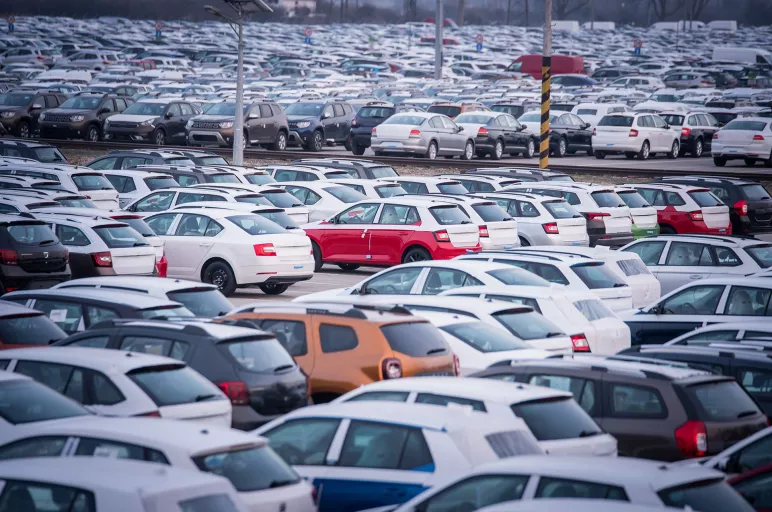
What’s Putting the Brakes on the Global Automobile Industry?
October 25, 2019 | Market Intelligence
The global automobile sector is taking its biggest hit since the 2008 economic slowdown. According to a report from Germany’s Center for Automotive Research (CAR), car sales are likely to dip by 4 million units in 2019 and the sector is not likely to recover until 2022. Car and commercial transport vehicle sales across the globe are in a state of decline.
While the US automobile industry reported a 2.4% drop in sales for the first half of 2019, sales data from the European Union car industry has similarly shown a steady decline since September 2018 with annual car sales dropping by about 7%. Meanwhile, Chinese automobile manufacturers have witnessed declining car sales for the last 14 consecutive months, with China registering a 3% drop in passenger car sales for the first time in the last 20 years. The Indian car market is in an even worse condition, showing a 41% decline in annual sales in August 2019. The global slowdown in automobile sales has emerged from a complex interplay of causes. Geopolitical factors, regulatory pressure, and changes in consumer behavior have combined to put the brakes on the global automobile industry.
The US-China Trade War
One of the biggest causes behind the global slowdown in car sales has been the trade war between the two biggest automotive manufacturers in the world. The United States government under President Trump imposed taxes up to 27.5% on cars and car parts imported into the U.S. from China. In response, China increased tariffs on vehicles manufactured in the United States from 15% to 40%. Although the move was temporary and revoked later, this and other constant exchanges of trade policy salvos between the two largest economies in the world have directly impacted the global automobile industry.
Changing Global Emission Norms
Countries that are major automobile manufacturing and sales hubs — such as China and India — have started imposing a series of new and stringent emission regulations on automakers. China’s new 6a emission standard will be one of the most stringent anti-pollution norms in the world and Chinese light vehicles will need to comply with these new standards by Jul. 1, 2020. In a similar move, the Indian government has also set an April 2020 deadline for original equipment manufacturers to comply with the new Indian BS6 emission standards. These deadlines have put automobile and other original equipment manufacturers under immense strain in both countries as they scramble to ensure that they are ready to start producing vehicles that meet these new standards.
Meanwhile, countries across Europe have started banning the use of diesel cars on the road. Because of this ban, the European car industry has been in a state of severe decline. Since 1980, Europe has been the world’s biggest market for diesel cars. However, the popularity of diesel cars has been in decline across the continent, as more people have become aware of the threats diesel-powered engines pose to the environment and public health due to the high emission of toxic pollutants and following the Volkswagen emission scandal of 2015.
Changes in Customer Taste and Behavior
With emission norms requiring cars to adhere to stricter regulations, government policies pushing for a ban on diesel cars and policymakers offering incentives for consumers who move toward clean automotive technology — such as hybrids and electric cars — customers across the world have decided to wait for new emission norms to kick in and to see how automobile technology progresses toward cleaner and more fuel-efficient cars, in the hope of lowering their overall ownership costs and buying superior products. This tendency by consumers is exacerbating the slowdown in car sales and is expected to continue to put the brakes in the automotive industry as the world approaches the deadlines of various new emission standards.
Another factor that has reduced the need for car ownership is the prevalence of ride-sharing applications such as Uber, Ola and Lyft. The Chinese ride-hailing market recorded an annual turnover around $53 billion, while the U.S. registered a turnover around $49 billion. India has also observed significant growth in the number of customers using ride-sharing platforms, increasing from 1 million rides per day in 2015 to 3.5 million rides per day in 2018. Over 30% of the population of China uses ride-sharing platforms to commute, with similar figures in the United States (20%) and the EU (18%). This change in customer behavior is expected to intensify in the coming years, as ride-sharing offers commuters the benefits of owning a car without the drawbacks of increasing acquisition and maintenance costs. Conversely, growth in the increase of the customer base of ride-sharing platforms is not expected to translate proportionately into automobile sales, as one car on a ride-share app can substitute the need for anywhere from 8 to 12 individually owned cars.
Conclusion
Many car manufacturers have responded to the slowdown by closing their manufacturing plants, either temporarily or permanently, sometimes on a regional level but also globally. Some of the car companies that have announced the closing of manufacturing plants in 2019 include Honda, Nissan and General Motors. Other automobile original equipment manufacturers are safeguarding against the slowdown in the automotive industry by investing heavily in new technologies, including cars powered by alternative fuels (electricity, biodiesel, hybrids) and cars that offer improved safety and emission norms. However, adopting these changes comes at a significant cost to the original equipment manufacturers and is putting immense strain on the profitability of the automotive sector.



